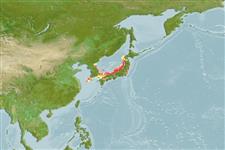>
Perciformes/Cottoidei (Sculpins) >
Cottidae (Sculpins)
Etymology: Cottiusculus: Greek, kottos = a fish, diminutive; nihonkaiensis: Named for Nihonkai, the Japanese name of the Sea of Japan, which includes most of the distributional range of the species.
Environment: milieu / climate zone / depth range / distribution range
Ecología
marino demersal; rango de profundidad 100 - 150 m (Ref. 83439). Temperate
Distribución
Países | Áreas FAO | Ecosistemas | Ocurrencias, apariciones | Point map | Introducciones | Faunafri
Northwestern Pacific: from the Sea of Japan coasts of Hokkaido, Honshu, Kyushu and the Korean Peninsula, and Volcano Bay, Hokkaido.
Tamaño / Peso / Age
Maturity: Lm ? range ? - ? cm
Max length : 7.8 cm SL macho / no sexado; (Ref. 83439); 6.1 cm SL (female)
Short description
Claves de identificación | Morfología | Morfometría
Espinas dorsales (total) : 6 - 8; Radios blandos dorsales (total) : 11 - 13; Espinas anales: 0; Radios blandos anales: 10 - 13. This species is distinguished by the following set of characters: simple or weakly bicuspid nasal spines; uppermost preopercular spine not barbed; first dorsal fin not elongated; lateral line extending past base of caudal fin, with 2 or 3 lateral line pores on caudal fin; with ventral lateral and lateral line cirri (Ref. 83439).
Usually occurs on sandy-muddy bottoms (Ref. 83439).
Life cycle and mating behavior
Madurez | Reproducción | Puesta | Huevos | Fecundidad | Larva
Kai, Y. and T. Nakabo, 2009. Taxonomic review of the genus Cottiusculus (Cottoidei: Cottidae) with description of a new species from the sea of Japan. Ichthyol. Res. 56(3):213-226. (Ref. 83439)
IUCN Red List Status (Ref. 130435: Version 2024-1)
Threat to humans
Harmless
Human uses
Herramientas
Special reports
Download XML
Fuentes de Internet
Estimates based on models
Phylogenetic diversity index (Ref.
82804): PD
50 = 0.6250 [Uniqueness, from 0.5 = low to 2.0 = high].
Bayesian length-weight: a=0.00955 (0.00344 - 0.02648), b=3.09 (2.85 - 3.33), in cm total length, based on LWR estimates for this (Sub)family-body shape (Ref.
93245).
Nivel trófico (Ref.
69278): 3.3 ±0.5 se; based on size and trophs of closest relatives
Resiliencia (Ref.
120179): Medio, población duplicada en un tiempo mínimo de 1.4-4.4 años (Preliminary K or Fecundity.).
Fishing Vulnerability (Ref.
59153): Low vulnerability (10 of 100).
